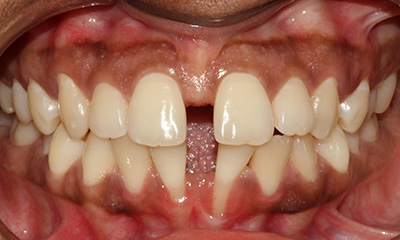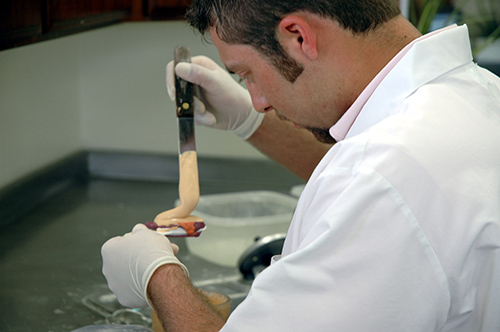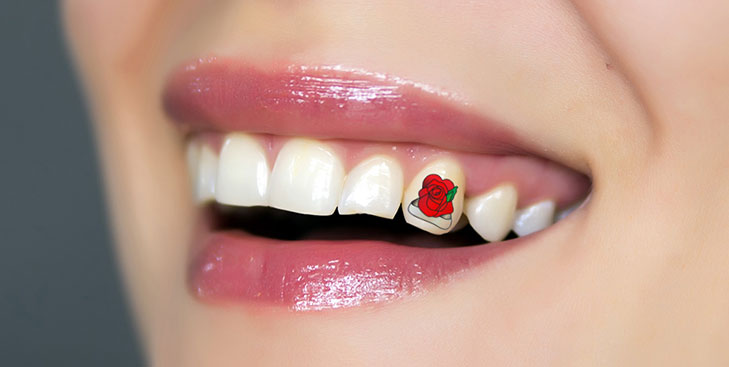As noted in an a previously published blog, according to the AACD, 74% of adults feel that an unattractive smile can negatively impact a person’s chances for career success. In the job market of life, people are always coached to “dress for success” and that you “never get a second chance to make a first impression”. When considering this, is there anything more unique and essentially you, than a glowing smile? It really is everyone’s unique accessory. A warm and welcoming smile can brighten up your overall look and give you a natural glow. It attracts positive vibes as it makes you look friendly, approachable, and confident.
However, a many of us are self-conscious of our smiles, not happy because of different issues like tooth discolorations, cracks, uneven or missing teeth, and noticeable gaps.
 In conditions such as these, wearing you smile “accessory” becomes a dreaded ritual. Unlike blemishes or pimples that can be concealed with makeup, there is no easy way to hide the imperfections in our teeth. As much as we would like to flash a cheerful smile, we become mindful with how it will look like and worry sets in. In the end, we often simply shut our mouth and lower our head.
In conditions such as these, wearing you smile “accessory” becomes a dreaded ritual. Unlike blemishes or pimples that can be concealed with makeup, there is no easy way to hide the imperfections in our teeth. As much as we would like to flash a cheerful smile, we become mindful with how it will look like and worry sets in. In the end, we often simply shut our mouth and lower our head.
Thankfully, with a qualified cosmetic dentist and a partnering dental laboratory, there are services and procedures that can turn our not-so-pleasant dentition into a superstar smile. These procedures are collectively known as a smile makeover. This is a set of dentistry procedures that aims to repair and fix dental issues to result to a beautiful, red-carpet smile. Dentists and orthodontists combined the art of cosmetics and the science of restoration to help patients obtain a picture-perfect smile and eventually boost their confidence and self-esteem.
Identifying Your Needs
Before you rush to your dentist, it is important to first identify what needs to be improved or repaired with your smile. Since the teeth are connected to the jaw, some changes to your smile may actually affect your facial appearance. Depending on the severity of a patient’s dental issues, a smile makeover can vary from the simple to a more complex series of dental implants and surgery. These set of procedures are aimed to fix the following dental concerns:
Teeth discoloration
There are many reasons as to why our teeth color changes from white to either yellowish, light brown, or gray. This may be caused by natural and artificial food coloring or chemicals from the food we eat. Coffee, for example, is known to cause teeth discoloration because of its high caffeine content. Smoking and improper oral hygiene also cause teeth discoloration.
Spacing and alignment
Although some people have naturally-crooked teeth and visible gaps, spacing and alignment issues on our teeth can be caused by myofunctional (movement of oral muscles) habits such as mouth breathing, jaw gnashing, reverse swallowing, and thumb sucking. These mannerisms result to incorrect jaw development and improper teething.
Cracks, chips, and missing teeth
 Lack of calcium and fluoride weakens our teeth and makes them prone to breakage especially when we bite or chew hard food. If not treated early, cracks and chips on our teeth will totally damage the teeth’s enamel and expose the pulp or nerve inside, which could lead to tooth extractions.
Lack of calcium and fluoride weakens our teeth and makes them prone to breakage especially when we bite or chew hard food. If not treated early, cracks and chips on our teeth will totally damage the teeth’s enamel and expose the pulp or nerve inside, which could lead to tooth extractions.
Uneven and imbalanced gum and facial contour
Our gums are connected to our facial muscles and tissues, and any imperfection in our teeth could radiate to the gums and up to our face. This also causes misaligned bites and, in extreme cases, partial paralysis on some oral muscles.
When you have determined what needs to be fixed with your smile, you can then visit a dentist and inform him of your concern. Further assessments will be done by the dentist to identify which procedure needs to be performed.
Types of Smile Makeover Procedures
Once the needed procedure has been identified, the dentist will orient you first and may perform additional tasks before starting. Most dentists take a photos of your smile before the procedure so they have a baseline point and can document the success of the smile makeover and help determine how successful it is. There are six types of procedures that a dentist can do to fix your smile, depending on the gravity of dental damage.
Teeth whitening
Using dental bleach or other materials, this procedure removes stains and discoloration on the surface of our teeth. The cleaning material will either be applied directly on the teeth or placed in a mouthpiece that the patient will bite afterwards. The teeth will then be exposed to a curing light or dental laser to speed up the cleaning process.
Fillings
Cracks and small chips on your teeth can be restored with fillings. These close off the spaces and prevents further damage to the impacted tooth. Dental fillings could either be gold, silver (also known as amalgam filling), or composite resin. Nowadays, though, gold and amalgam fillings are rarely used because they are quite costly, plus their color doesn’t match the teeth, making them very obvious and visible. Composite resin fillings come in different shades to match different teeth colors. The dentist will clean and dry the impacted tooth first and then the filling will be applied. Using a curing light or dental laser, the filling will slowly harden. The dentist might use dental burs from time to time to ensure to remove excess filling and smoothen the surface of the filled crack.
Braces
For misaligned teeth, crowded teeth, and tooth gaps, the dentist might recommend braces. These are mouthpiece-like instruments that a patient will wear for a certain period of time to realign the teeth through constant pressure. Braces are usually made of stainless steel wires and rubber bands. However, there is already an alternative to steel braces known as Invisalign®. This is a clear brace that looks like a mouthpiece.
The dentist will scan the teeth and create a 3d model of your dentition using plaster. This will be the mold for creating the braces. Once done, the braces will then be mounted on your teeth with adhesive. For steel braces, rubber bands will be attached to tighten the braces and induce pressure to the teeth. Regular visits back to your dentist will then be scheduled for rubber adjustments. Braces are to be worn for usually 6-24 months depending on the work needed to align the teeth.
Veneers
 These are tiny “sheets” of dental porcelain or composite resin that is placed over a tooth is lieu of fillings, especially when the damage is already quite large. Veneers cover the surface of an impacted tooth and prevent further damage to the enamel. This procedure is quite fast since the dentist will only need to apply adhesive to the impacted tooth (after cleaning and drying, of course) and put the veneer on it just like a sticker. In some cases, though, the dentist will need to reduce the enamel surface on the impacted tooth first using dental burs before putting the veneers. This ensures even surface of your teeth and prevents veneers from creating a slight bump.
These are tiny “sheets” of dental porcelain or composite resin that is placed over a tooth is lieu of fillings, especially when the damage is already quite large. Veneers cover the surface of an impacted tooth and prevent further damage to the enamel. This procedure is quite fast since the dentist will only need to apply adhesive to the impacted tooth (after cleaning and drying, of course) and put the veneer on it just like a sticker. In some cases, though, the dentist will need to reduce the enamel surface on the impacted tooth first using dental burs before putting the veneers. This ensures even surface of your teeth and prevents veneers from creating a slight bump.
Dental crowns and bridges
If an impacted tooth is already severely damaged that there are few enamel left, a dental crown will be attached to it to “cap” the damaged tooth. Dental bridges, on the other hand, are used to fill a missing tooth without resulting to surgery. Just like fillings, dental crowns and bridges are made of either gold, amalgam, or composite resin.
The dentist will reduce the impacted teeth (for dental crowns) or the teeth around the space left by the missing tooth (for dental bridges) and use a plaster impression to create a mold. Since creating a dental crown or bridge takes a few days, a temporary crown or bridge will be placed on the impacted tooth/area first. Once the dental crown or bridge is created, it will be placed on the impacted tooth/area and sealed with dental cement.
Dental implants
This is the most extreme procedure for a smile makeover. There are severe cases of tooth damage that extend up to the root of the tooth. In this scenario, a dental crown or bridge is not suggested as they cannot cover the hole left by the damaged root. Dental implants are tiny titanium posts that replace the root of the impacted tooth. They are secured to the jawbone or skull via surgery. A dental crown or bridge will then be attached to the titanium post to fill the gap. Dental implants can also be used to fill a missing tooth in lieu of dentures. This procedure is the last resort for dentists as it is quite expensive and a little risky. However, once successfully installed, dental implants are the toughest among the six procedures and they require minimal maintenance.
Care and Maintenance
 There it is! A smile makeover results to a beautiful set of teeth that is always ready to flash a bright smile. Aside from their aesthetic value, these procedures also restore your teeth and prolong their lifespan. However, they may not be able to serve their purpose for a long time if not taken care of. With proper care and maintenance and a few adjustments on your oral hygiene, you are sure to have a perfect smile for many years, and even up to a lifetime.
There it is! A smile makeover results to a beautiful set of teeth that is always ready to flash a bright smile. Aside from their aesthetic value, these procedures also restore your teeth and prolong their lifespan. However, they may not be able to serve their purpose for a long time if not taken care of. With proper care and maintenance and a few adjustments on your oral hygiene, you are sure to have a perfect smile for many years, and even up to a lifetime.
Toothbrushing
Regular toothbrush and toothpaste may be too harsh and may abrade the surface of the restorations. This will result to dullness and reduced polish and luster for your restoration. Consult your dentist for any recommended non-abrasive toothbrush and toothpaste that you can use. Brush at least three times a day to maintain cleanliness and strength of the restoration.
Flossing
This is an important oral hygiene routine especially if you have veneers. Floss regularly after meals to prevent plaque buildup and prolong the life of the restorations.
Mouth rinsing
Alcohol-based mouthwash solutions are strongly discouraged for people with restorations. Alcohol can weaken the adhesive or cement bond of the restorations, causing it to loosen and weaken. Just like flossing, rinse your mouth regularly with alcohol-free mouthwash solutions.
Regulating your food and drink intake
Dentists advise that people with restorations must reduce their sugar intake and must lessen drinks that could stain the teeth like coffee and soda. Alcoholic beverages must also be moderated as they may weaken the restorations.
Handling your restorations well
Avoid biting and chewing hard objects to prolong the life of your restorations. If you are experiencing bruxism (grinding of teeth during sleep), do not forget to wear your night guard before sleeping to prevent damage.
Visiting your dentist regularly
Even if you are not wearing braces, a regular visit to the dentist is highly advisable so he can check if there are any minor adjustments or repairs that need to be done on your restorations.
Gone are the days when you just frown and seal your lips instead of smiling cheerfully. With a smile makeover, you can now face the world and charm everyone with a confidently beautiful smile. No need to skip trick or treating as well, and you can go and enjoy second helpings of your favorite dessert, too! Now, that will surely make you smile!




